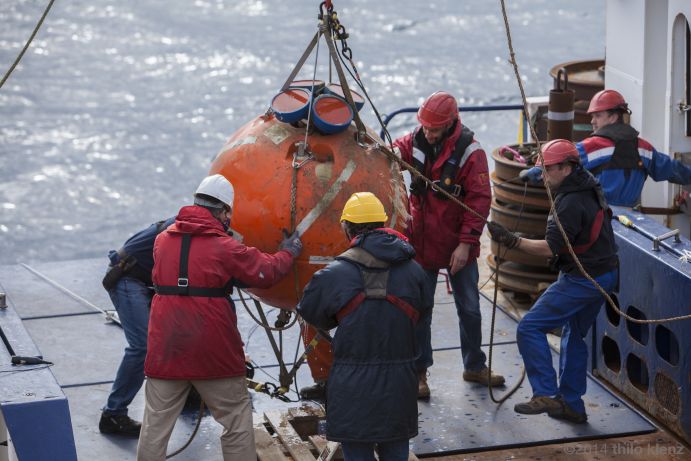Taking a deep breath? - Scientists measure unusually high oxygen uptake in the Labrador Sea
Stormy, rough and very cold: These characteristics of the Labrador Sea may initially seem rather uncomfortable, but they are of particular importance for the oxygen distribution in the ocean. An international research team, with the participation of the GEOMAR Helmholtz Centre for Ocean Research Kiel, has recently measured an exceptionally high oxygen uptake at a long-term measuring station up to water depths of more than 1,700 meters. The event was caused by the particularly cold winter conditions in 2014/2015. Despite the unusually strong uptake, the event cannot compensate the overall oxygen loss of the world's oceans. The results of the study have now been published in the international scientific journal Geophysical Research Letters.
The ocean surface, in constant gas exchange with the atmosphere, takes up oxygen from it. In the ocean, in particular the temperature and air bubbles influence the oxygen uptake, says Dr. Johannes Karstensen, oceanographer at GEOMAR and co-author of the study. If the ocean surface cools down, the water mass becomes denser and heavier. Thus, the water mass starts to sink to greater depth, including the absorbed dissolved oxygen. At the same time, water rises from deeper layers and gets enriched with oxygen again. Sometimes this process is compared to a waterfall but in reality it is somewhat different, says Dr. Johannes Karstensen. It is rather a re-layering where cooler, denser water sinks and the underlying lighter water rises, is then cooled down, sinks again, and so on.
As the data from the long-term measuring station K1 in the Labrador Sea show, an unusually high amount of oxygen was absorbed in the particularly cold and stormy winter of 2014/2015. On one hand, this was due to the fact that the vertical turnover process extended to depths of more than 1,700 meters. On the other hand, the scientists were able to show from the observational data that the observed oxygen increase can only be explained by taking into account the inflow of air bubbles at the surface. This result is particularly important for the correct modelling of oxygen uptake in deep-convection areas and also serves to improve climate prediction.
More recently, GEOMAR researchers have published a study on the temporal evolution of the oxygen concentration in the world ocean. It shows that the oxygen content of the world's oceans has decreased by more than two percent over the last 50 years. An obvious question is: Can the increased oxygen uptake in the Labrador Sea compensate the observed oxygen loss of the world oceans? Even if we assume that the water formed in 2014/2015 will be transported out of that region without any losses, only about one hundredth of the world's oceanic oxygen loss can be compensated, says Dr. Johannes Karstensen. In particular, the decrease in oxygen content in the surface water caused by global warming cannot be compensated. On the other hand, the data from the Labrador Sea also contribute to a better understanding of the global circulation processes. This allows better predictions of the future development of oxygen in the oceans, emphasizes the oceanographer from Kiel.
Original work:
Koeling, J., D. W. R. Wallace, U. Send, and J. Karstensen, 2017: Intense oceanic uptake of oxygen during 2014-15 winter convection in the Labrador Sea. Geophys. Res. Lett. http://dx.doi.org/10.1002/2017GL073933




